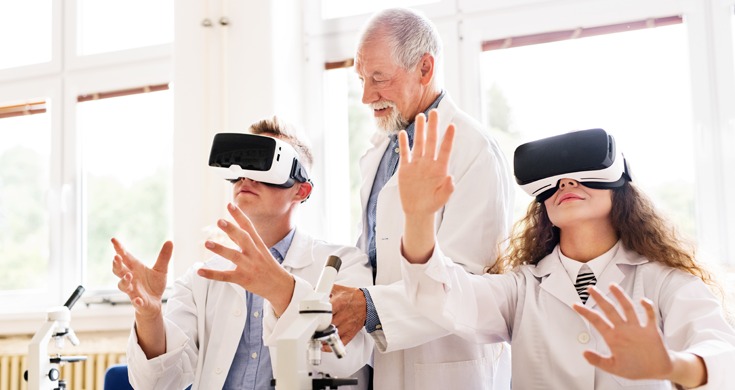Education is no longer restricted to textbooks and long lectures. With Virtual reality, various universities and colleges have changed their approach to delivering knowledge to students, particularly in the science domain with VR Science labs. In this blog, we will explain what is a VR science lab and how it is helping students uncover the treasure of knowledge.
What is a VR Science Lab?
Think of VR Science as the replica of the physical laboratory but as a simulated environment using VR technology.
With VR Science labs, students are transported to a 3D world filled with a bundle of scientific discoveries. It offers an extreme level of immersion that makes learning highly engaging.
Just wear a VR headset and you will enter into a virtual room completely equipped with specimens, equipment, and other interactive elements that are not possible to have in a real classroom.
Not only this, but you can also roam around the virtual room, pick up those virtual tools, and manipulate the objects to perform experiments as if you are in a physical classroom lab setup.
Interesting. Isn’t it?
But how is it happening?
Well, virtual reality technology relies on a combination of cutting-edge components, that include powerful processors, motion sensors, and high-definition displays. All these elements work in harmony to create a sense of presence within the virtual world.
When students put on their VR headsets, they are no longer bound by the limitations of physical space. They can explore microscopic structures, journey to the depths of the ocean, or even travel back in time to historical scientific breakthroughs. This immersive technology offers a level of versatility and possibility that is truly unparalleled.
Advantages of VR Science Labs
VR science lab is not just another technological tool.
Yes! It is a gateway to a new learning world that offers immersive, interactive, and safe opportunities to the students where they can explore and interact with virtual elements to learn about the wonders of science.
Here is why VR in science is essential for students-
Enhanced Engagement and Interactivity
The traditional education setup involves students sitting with rows of desks, and a teacher delivering a lecture. However, long lectures and textbook often seems boring to students making them steer at the clocks as this approach makes them think of education as a chore.
What if delivering lectures or learning about a new concept becomes engaging?
This is what VR science labs offer to the students.
By wearing a VR headset, the students can learn about chemical reactions as if they are some mad scientists brewing concoctions with their own virtual hands. Thus, turning a boring lecture into an interactive experience.
It is like a hands-on experience that ignites the spark of curiosity within the students. It helps them to understand concepts more deeply.
It is because they are not merely memorizing facts, but are also experiencing the scientific method firsthand. The sense of control and agency in a VR science lab empowers them to explore beyond the textbooks.
Thus, inviting the students to become the scientists, the explorers, and the discoverers all at once.
Safe and Controlled Environment
Performing science experiments in a physical lab can be dangerous. There is a constant fear of accidents and contact with hazardous materials.
The very mention of chemistry experiments or dissecting specimens might bring back memories of cautiously handled glassware and lab coats.
But with VR, students can step out of these concerns and perform experiments without worrying about the risk associated with the experiment.
VR pushes the boundaries and allows the students to make mistakes and explore the wonder of science by performing virtual science experiments.
Within the controlled environment of virtual reality labs, there are no Bunsen burners to accidentally singe your fingers or toxic chemicals to avoid inhaling.
With its trial and error ability, your flaws are not only accepted but are also encouraged.
Did you mix the wrong compounds?
No worries!
Just reset the experiment and you are ready to start again.
And, do you know what is the best part? It’s that there is no rush and no pressure. The students are allowed to take their time, observe the results, and ponder the mysteries of science with curiosity.
Access to Expensive Equipment and Resources
An experimental lab that is filled with all the latest gadgets like spectrometers or high-powered microscopes is only possible for a few institutions. Well, for most of us, this is a distant dream because it is quite expensive.
Budget can constrain the students to use such useful equipments.
However, cost is not a concern when it comes to experimenting within a VR science lab. By just wearing the VR headset and holding the controllers, the students are allowed to access digital assets like virtual microscopes and spectrometers.
Now, they can examine the most intricate structures, tinker with compounds, and explore scientific frontiers without any limitations.
Customizable Learning Experiences
The cookie-cutter approach of the traditional educational setup is old enough to have an impact on students’ learning.
Today, we understand that every student learns at his own pace. Virtual reality helps educators to customize their lectures as per the needs of students.
For a biology class, they can create a virtual environment resembling a vibrant jungle or the internal human body, allowing the virtual learners to take a look at what they have to remember. Such adaptability enhances engagement, understanding, and retention among students.
And, this is the end goal of education. Right?
Conclusion
So, while summing up, we can say that in the VR Science Lab, the students take an interesting journey of self-discovery. They not only adapt to the curriculum but the curriculum adapts to them. No matter if they are a visual, auditory, or kinesthetic learner, VR is there to help them out with ease.
As this technology continues to evolve, the potential for transforming education across various disciplines is limitless. It is the right time to adopt this technology and get ready to see a future of immersive learning with Virtual Reality.









